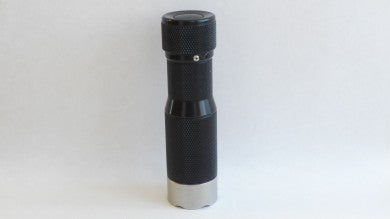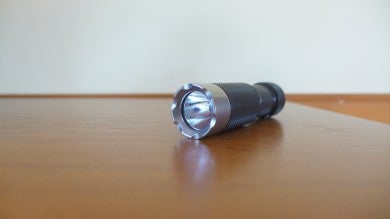Our Pick for the One Light to Reach For in an Emergency
Tony Sculimbrene 01.14.15

Which light would you depend on when you need illumination the most? The expedient answer is simple: the one nearest to you. But beyond that functional but unhelpful answer, what would you say?
My answer was something I came to pretty quickly. I heard a loud crashing outside and ran to see what it was. Which light did I grab on my way out the door? The HDS Rotary.
Truth is, this has been the answer to the the above question since I got the light. It’s not my preferred EDC light or my most powerful light, but when, as Warren Zevon says, it comes time to “send lawyers, guns, and money,” I’d also ask for an HDS Rotary.
In thinking about why this is case, I discovered that the reasons for this choice explain a lot about what you should look for in a modern flashlight. This is really a companion to my article on why the Spyderco Dragonfly II in ZDP-189 is the perfect EDC knife, a position I still stand by today.
For those who don’t follow lights, the HDS Rotary is the latest design from HDS. Here is the product page. Here is my review. Here is the latest of 16 threads on the HDS lights. They have made a number of the most important flashlights in the last ten years. The Rotary is their current flagship, and aside from emitter upgrades, I am not sure how they could go about improving it. This is especially true after they released the new universal clip (which I have been using for about a week and it’s amazing). The argument for the HDS Rotary as your one light, your go-to light is anchored by three points: durability, ease of use, and size/shape.
One thing to get out of the way first is the battery format. Sure, AA and AAA are more readily available and they are, thanks to new emitters, perfectly competent. For EDC use, they are my favorite. But if you need something to work without fail, then CR123a batteries are superior. They have a longer shelf life, and they perform better in hot and cold. Alkalines do better in water, but in a sealed housing like the HDS Rotary, that’s irrelevant.
For EDC I like something else, but if you absolutely positively need light, then primary cell (that is, non-rechargeable) CR123a batteries are the best choice. They can be had relatively easily (and weird enough, because so few devices use them I have found them more available in emergencies than their common cell brethren). They aren’t cripplingly expensive. They have plenty of capacity and power, and they are a very handy size. For emergency cells, it’s hard to be CR123a’s.
One other thing–I know a lot of people like headlamps, and they are very good. If I knew I would be working outside a lot or with my hands, I’d take one. But in many of the situations I have been in where I needed light, it was handier to have a flashlight. A flashlight could tailstand, it could illuminate things with me needing to turn my head, and I could hand it off to folks. Headlamps are good, but for general emergency use, I like the Rotary.
I could also easily make an argument that high end lanterns, such as the R-Pal, should be in the running, but again general utility tasks are best performed by a flashlight.
Durability
Thick, beefy walls of aluminum, fat Acme threads to prevent cross threading, fully potted (glued in place) electronics, seals and o-rings at every point–the Rotary is built to withstand a huge amount of abuse.
There are other lights that have these features, though. It’s the next level that distinguishes the Rotary from everything else. The switches are sealed and gold plated for greater reliability. The light is also designed with thermal management. Finally, the stock lens is a hardened and anti-reflective glass, but there is an upgrade option for a sapphire lens, something usually reserved for high end watches and lenses. This is not a thin walled budget junker; this is a light that can take just about whatever you’ll face. Even the new universal clip is extra hardy, coming in at about twice the thickness of normal clips.
HDS went out of their way to make this light the heartiest and most robust light out there.
Ease of Use
In New England we get pretty big snow storms. It’s not constant snow like elsewhere, but Nor’easters take out our power at least once a year, and about every five years we lose it for a substantial period of time. Since living here I have gone without any power for five days once, four days once, and three days a couple of times. In these scenarios, especially with the limited winter daylight, flashlights are crucial to get things done.
Being an avowed flashaholic, I have more than enough to get me by, but I did loan my lights out to lots and lots of folks. Most often my wife borrowed my light, but as we got power back and others didn’t, I gave lights to my friends and coworkers (those folks don’t make fun of me anymore for collecting flashlights). In these scenarios, having a light that is easy to use is a huge plus. Tree branch down across the driveway? I am moving it and my wife is lighting my way. Ease of use is tremendously important.
The HDS Rotary’s user interface, though capable of all sorts of interesting and handy tricks for advanced users, is dead simple–push button then twist for more light.
That’s it. That’s all you need to say when you hand the light to a person that though flashlights only came in 2xD cell plastic numbers. Anyone and everyone can use the HDS Rotary, and anyone and everyone can access its variable brightness.
There are a lot of selector ring lights out there. I have reviewed a bunch, but none are as well done as the Rotary. First, the button and the ring are on the same end of the light. In some models this isn’t the case, and those designs necessitate two hand use.
Second, in many selector ring only designs, the selector ring is just beneath the head of the light. That’s okay, but it doesn’t do so well if you want to use your light in any non-standard grips. The positioning of the ring on the Rotary does well in any grip.
Simple UI and elegant design make the Rotary exceedingly easy to use.
Size and Shape
This light has crawled into my oil tank room with me. It has jumped up into a frigid attic. It has dodged hail.
The Rotary is not the size of an EDC favorite, like the Muyshondt Aeon Mk. II, but it’s also not so big that I feel like I am lugging around the plumbing under my kitchen sink. It’s also the right size to have a real reflector and to do real work.
Thanks to good thermal management and the right battery, the light can run for a while on high (of 250 lumens over 2 hours) and forever on low (.02 lumens for all eternity essentially). The light is comfortable in the hand as well, thanks to a distinctive “waist.” It’s also capable of tailstanding, though there are instances in which it can be unstable–you might need to vent the switch. The addition of a very good clip just makes the HDS Rotary that much better.
The Golidlocks Principle wins the day–big enough to handle anything, but not too big to carry.
In emergencies I reach for this light. I have a huge array of very nice flashlights, but this is the one I reach for. If I had to go down to just one light, the Aeon and the Rotary would fight to the death, but the Haiku, the SPY 007 and the Peak Eiger would all go quickly. The HDS Rotary is the best all around and emergency light on the market. It’s pricey, but everything this reliable is.


